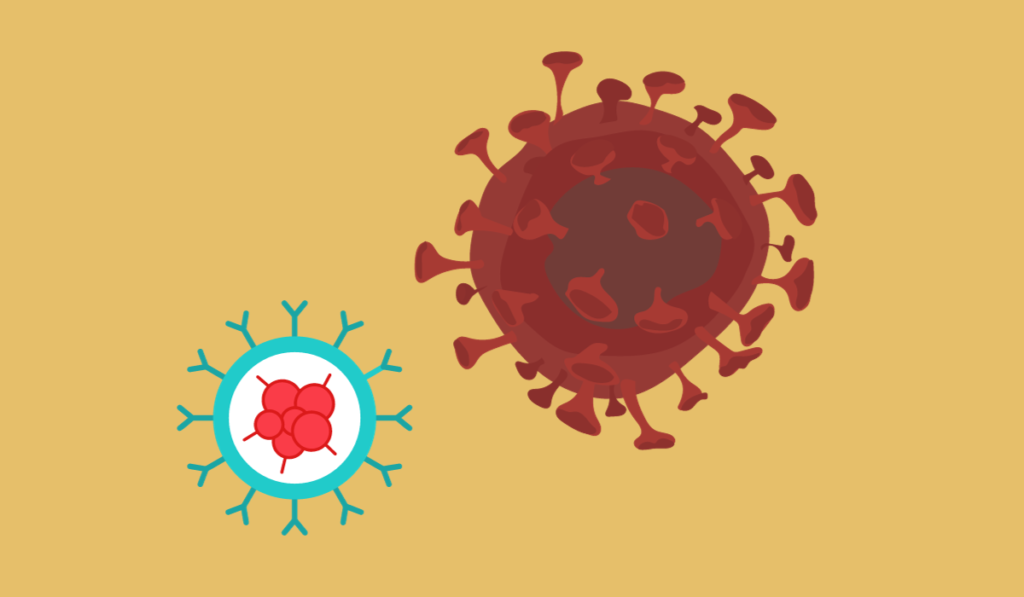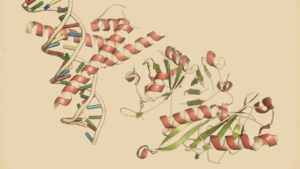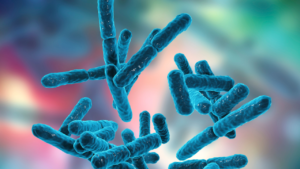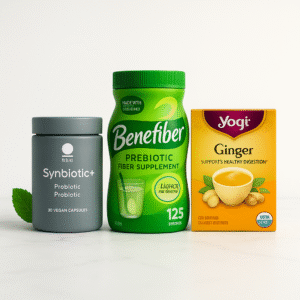Colon Cancer Under Siege: The Gut Microbiome’s Role in Defense
Explore the intricate relationship between the gut microbiome and colorectal cancer (CRC) in our comprehensive analysis.

Introduction
In the ever-evolving battle against colon cancer, science has uncovered a new and unlikely ally: the trillions of tiny organisms residing within our digestive system, collectively known as the gut microbiome.
As researchers delve deeper into the mysteries of this microscopic community, they are discovering that it plays a pivotal role in defending our bodies against the threat of colon cancer.
This partnership between our gut and its microbial inhabitants has ushered in a new era of understanding, where the complex interplay of bacteria, genes, and inflammation becomes the frontline in the fight against one of the most prevalent and formidable cancers of our time.
In this exploration, we embark on a journey to unravel the mechanisms by which our gut microbiome stands as a formidable fortress against colon cancer, shedding light on the potential for groundbreaking preventive and therapeutic strategies.
Join us as we peer into the world of "Colon Cancer Under Siege" where our body's own defenders hold the key to a brighter, cancer-free future.
Gut Microbiome: Friend or Foe in the Battle Against Colon Cancer?
We now have strong evidence that the community of tiny organisms living in our gut called the gut microbiome, has a big impact on our intestinal health.
This microbiome is made up of trillions of microbes, including over 1,000 types of bacteria with more than 3 million genes.
These tiny creatures can do good things like helping keep our intestines healthy and fighting against cancer.
However, they can also cause problems like chronic inflammation and even contribute to the development of colon cancer.
Whether the gut microbiome is a friend or foe may depend on the kinds of bacteria living there and the balance between helpful and harmful ones.
When this balance gets disrupted, it's called dysbiosis, and we've seen it in people with colorectal cancer (CRC).
But we're still trying to figure out if these changes in the gut come before CRC or if they happen as a result of it.

Evidence of Gut Microbiota's Role in Colon Tumor Protection
The Gut Microbiota's Impact on Colon Tumors
Studies in mice show that the gut microbiota plays a crucial role in protecting against colon tumors Couturier-Maillard A, Secher T, Rehman A, et al. NOD2-mediated dysbiosis predisposes mice to transmissible colitis and colorectal cancer. J Clin Invest 2013;123(02):700–711. Couturier-Maillard A, Secher T, Rehman A, et al. NOD2-mediated dysbiosis predisposes mice to transmissible colitis and colorectal cancer. J Clin Invest 2013;123(02):700–711. Hu B, Elinav E, Huber S, et al. Inflammation-induced tumorigenesis in the colon is regulated by caspase-1 and NLRC4. Proc Natl Acad Sci U S A 2010;107(50):21635–21640.These findings have significant implications for human health.
Mouse Models Reveal the Gut Microbiota's Influence
Inflammation-induced colon tumorigenesis was studied in mice.
They were exposed to a carcinogen called azoxymethane (AOM) and administered water containing dextran sulfate sodium (DSS) to induce inflammation.
Mice lacking specific immune receptors (Nod-like receptors or NLRs) that sense bacteria developed larger tumors compared to normal mice.
This suggests that commensal bacteria can limit colon tumorigenesis by activating these receptors Zaki MH, Lamkanfi M, Kanneganti TD. The Nlrp3 inflammasome: contributions to intestinal homeostasis. Trends Immunol 2011;32(04):171–179. Zaki MH, Vogel P, Malireddi RK, et al. The NOD-like receptor NLRP12 attenuates colon inflammation and tumorigenesis. Cancer Cell 2011;20(05):649–660. Chen GY, Liu M, Wang F, Bertin J, Núñez G. A functional role for Nlrp6 in intestinal inflammation and tumorigenesis. J Immunol 2011;186(12):7187–7194.The Impact of Germ-Free Mice
Mice without any gut microbes (germ-free mice) also developed more tumors than conventionally housed mice when exposed to AOM and DSS Zhan Y, Chen PJ, Sadler WD, et al. Gut microbiota protects against gastrointestinal tumorigenesis caused by epithelial injury. Cancer Res 2013;73(24):7199–7210.The gut microbiota protects against tumors through various mechanisms:
- Promotion of Epithelial Repair and Barrier Function: Commensal bacteria aid in repairing damaged intestinal tissue and maintaining a healthy barrier, which helps resolve inflammation.
- Negative Regulation of Inflammatory Pathways: Commensal bacteria negatively regulate pathways that can lead to tumorigenesis.
- Increased Apoptosis of Tumor Cells: Bacteria enhance the natural process of programmed cell death in tumor cells.
- Prevention of Dysbiosis: They maintain a balanced microbial community in the gut.
- Upregulation of Cytokines: Bacteria stimulate the production of cytokines like IL-18, which aid in tissue repair and fight against tumors.
Short-Chain Fatty Acids (SCFAs) and Butyrate
Certain metabolites produced by gut bacteria, like short-chain fatty acids (SCFAs), have important effects. SCFAs, including butyrate, are produced when bacteria ferment dietary fiber. Butyrate is especially crucial as it:
- Serves as an energy source for intestinal cells.
- Modulates inflammation, cell proliferation, and apoptosis.
- Affects immune cells like macrophages and leukocytes.
The Role of Butyrate and Receptors
Butyrate is recognized by host receptors GPR109 and GPR43 Ganapathy V, Thangaraju M, Prasad PD, Martin PM, Singh N. Transporters and receptors for short-chain fatty acids as the molecular link between colonic bacteria and the host. Curr Opin Pharmacol 2013;13(06):869–874.
Mice lacking GPR109a are more susceptible to colon tumorigenesis, showing the protective effects of bacterial products.
Butyrate induces anti-inflammatory responses in dendritic cells and macrophages, promoting regulatory T cell differentiation Singh N, Gurav A, Sivaprakasam S, et al. Activation of Gpr109a, receptor for niacin and the commensal metabolite butyrate, suppresses colonic inflammation and carcinogenesis. Immunity 2014;40(01):128–139.Genetic Factors and Butyrate
Genetic factors can influence the microbiota's effects. In mice with specific genetic mutations, butyrate can stimulate colon cell proliferation and increase tumor development.
So, genetic factors interact with the microbiota in tumor development Belcheva A, Irrazabal T, Robertson SJ, et al. Gut microbial metabolism drives transformation of MSH2-deficient colon epithelial cells. Cell 2014;158(02):288–299.Other Bacterial Metabolites
Secondary bile acids produced by gut bacteria, such as deoxycholic acid (DCA) and lithocholic acid (LCA), have cytotoxic properties.
They can damage cell membranes and generate reactive oxygen species, leading to inflammation and tumorigenesis Louis P, Hold GL, Flint HJ. The gut microbiota, bacterial metabolites and colorectal cancer. Nat Rev Microbiol 2014;12(10):661–672. Ochsenkühn T, Bayerdörffer E, Meining A, et al. Colonic mucosal proliferation is related to serum deoxycholic acid levels. Cancer 1999;85(08):1664–1669.Impact of Epithelial Barrier
Normally, the gut microbiota stays in the colon lumen, separated from the epithelium by a mucus layer.
When the barrier is breached due to injury or inflammation, bacteria can enter the mucosa, causing chronic inflammation linked to tumor development Swidsinski A, Khilkin M, Kerjaschki D, et al. Association between intraepithelial Escherichia coli and colorectal cancer. Gastroenterology 1998;115(02):281–286.Receptors and Tumor Development
Commensal bacteria are sensed by receptors like Toll-like receptors (TLRs). Activation of TLRs through MyD88, an adaptor protein, is associated with increased colon tumorigenesis.
This implies that the microbiota's interaction with specific receptors can influence tumor development Grivennikov SI, Wang K, Mucida D, et al. Adenoma-linked barrier defects and microbial products drive IL-23/IL-17-mediated tumour growth. Nature 2012;491(7423):254–258. Rakoff-Nahoum S, Medzhitov R. Regulation of spontaneous intestinal tumorigenesis through the adaptor protein MyD88. Science 2007;317(5834):124–127.Immune Cell Development and Tumor Susceptibility
Germ-free mice have impaired immune cell development, including Th17 and regulatory T (Treg) cells.
The balance between proinflammatory Th17 responses and anti-inflammatory Treg cells affects tumor susceptibility Wu S, Rhee KJ, Albesiano E, et al. A human colonic commensal promotes colon tumorigenesis via activation of T helper type 17 T cell responses. Nat Med 2009;15(09):1016–1022.Impact of Treg Cells
Although Treg cells suppress antitumor responses, their role in colon cancer progression remains unclear.
In the presence of antitumor cells, Tregs can be detrimental, while in the presence of proinflammatory responses, Tregs become protective Zhang X, Kelaria S, Kerstetter J, Wang J. The functional and prognostic implications of regulatory T cells in colorectal carcinoma. J Gastrointest Oncol 2015;6(03):307–313. Ladoire S, Martin F, Ghiringhelli F. Prognostic role of FOXP3þ regulatory T cells infiltrating human carcinomas: the paradox of colorectal cancer. Cancer Immunol Immunother 2011;60(07):909–918.The Gut Microbiota's Dual Role
Mouse studies show that the gut microbiota can either promote health or tumor progression depending on its inflammatory and proliferative effects.
Dysbiosis, or disturbances in the gut microbiota composition, can lead to tumorigenesis Man SM, Zhu Q, Zhu L, et al. Critical role for the DNA sensor AIM2 in stem cell proliferation and cancer. Cell 2015;162(01):45–58. Hu B, Elinav E, Huber S, et al. Microbiota-induced activation of epithelial IL-6 signaling links inflammasome-driven inflammation with transmissible cancer. Proc Natl Acad Sci U S A 2013;110(24):9862–9867 [Corrected in “Proc Natl Acad Sci U S A 2013;110(31):12852” (Note: Wunderlich, Claudia [added]; Wunderlich, Thomas [added])].
Microbial Signatures and Colon Cancer Risk
Identifying specific microbial signatures that predict colon cancer risk is crucial.
The composition of the gut microbiota plays a pivotal role in determining susceptibility to colon tumors, with changes in the microbial community structure directly impacting tumor development Zackular JP, Baxter N, Chen GY, Schloss PD. Manipulation of the gut microbiota reveals role in colon tumorigenesis. mSphere 2015;1(01):e00001–e00015. Zackular JP, Baxter NT, Iverson KD, et al. The gut microbiome modulates colon tumorigenesis. MBio 2013;4(06):e00692–e13.Unlocking the Secrets of Gut Microbiome
Did you know that most of the bacteria living in your gut are really picky eaters?
They're called "strictly anaerobic," which means they can't grow in a lab.
But scientists have found a way to study them without growing them in a petri dish.
The DNA Code Breaker
Scientists have a super cool trick up their sleeves: they can identify these bacteria using DNA.
They look at special parts of a molecule called "bacterial 16S ribosomal RNA."
It's like a secret code that helps them figure out which bacteria are chilling in your gut.
They call these groups "operational taxonomic units" (OTUs), which are kinda like different types of bacteria that are 97% similar to each other.
The Hunt for the Gut's VIP Club
A while back, there was a big science project called the Human Microbiome Project (HMP).
They wanted to know if there's a special group of bacteria that every healthy person has in their gut, like a "core" microbiome.
The HMP started in 2008 with 300 awesome volunteers who let scientists take samples from 15 or 18 different body parts, including the gut.
Guess what they found? No one-size-fits-all bacteria club! That means there's no single group of bacteria that's the same in every person. Human Microbiome Project Consortium. Structure, function and diversity of the healthy human microbiome. Nature 2012;486(7402):207–214.Our gut bacteria are as unique as we are.
But here's the kicker – even though everyone's bacteria are different, they can still be grouped into four types when we look at stool samples. Ding T, Schloss PD. Dynamics and associations of microbial community types across the human body. Nature 2014;509(7500):357–360.Bacteria and Disease: The Mystery
Now, here's where it gets interesting. Scientists are trying to figure out if changes in gut bacteria are linked to diseases.
But it's tricky to say for sure in humans, though they've figured it out in mice. Zackular JP, Baxter NT, Iverson KD, et al. The gut microbiome modulates colon tumorigenesis. MBio 2013;4(06):e00692–e13.Some studies suggest that there's something different in the gut bacteria of people with colorectal cancer (CRC). But here's the catch – different studies find different changes, and they usually involve small groups of patients.
For example, in one study, they found more Bacteroides and Prevotella bacteria in CRC patients. Sobhani I, Tap J, Roudot-Thoraval F, et al. Microbial dysbiosis in colorectal cancer (CRC) patients. PLoS One 2011;6(01):e16393. But there's another study that found less of the bacteria that make a special substance called butyrate in CRC patients. Weir TL, Manter DK, Sheflin AM, Barnett BA, Heuberger AL, Ryan EP. Stool microbiome and metabolome differences between colorectal cancer patients and healthy adults. PLoS One 2013;8(08):e70803.It's like a puzzle with lots of pieces!
What's in Your Stool Matters
Scientists like to use poop samples to study gut bacteria because they're easy to collect. But here's the thing – poop only tells part of the story.
It mostly shows us the bacteria in the inside part of your gut, not the ones stuck to the surface.
But in monkeys, poop is a good stand-in for all the bacteria in the gut. Yasuda K, Oh K, Ren B, et al. Biogeography of the intestinal mucosal and lumenal microbiome in the rhesus macaque. Cell Host Microbe 2015;17(03):385–391. In humans, though, when they compared the bacteria in poop to the ones in the gut lining, they found some big differences.Momozawa Y, Deffontaine V, Louis E, Medrano JF. Characterization of bacteria in biopsies of colon and stools by high throughput sequencing of the V2 region of bacterial 16S rRNA gene in human. PLoS One 2011;6(02):e16952. Durbán A, Abellán JJ, Jiménez-Hernández N, et al. Assessing gut microbial diversity from feces and rectal mucosa. Microb Ecol 2011;61(01):123–133. Eckburg PB, Bik EM, Bernstein CN, et al. Diversity of the human intestinal microbial flora. Science 2005;308(5728):635–1638.It's like comparing apples and oranges!
But wait, there's more! Some studies looked at bacteria in normal and tumor tissue from people with CRC.
Surprise, surprise – they found differences there too, suggesting that the bacteria stuck to the gut lining might play a role in cancer. Gao Z, Guo B, Gao R, Zhu Q, Qin H. Microbiota disbiosis is associated with colorectal cancer. Front Microbiol 2015;6:20. Marchesi JR, Dutilh BE, Hall N, et al. Towards the human colorectal cancer microbiome. PLoS One 2011;6(05):e20447.Gut Bacteria as Disease Detectives
So, here's the cool part. Your gut bacteria might be like detectives for disease.
One study found six special OTUs in poop samples that were linked to CRC.
And when they combined these bacterial clues with other stuff like age and body weight, they got really good at spotting who had CRC and who didn't Zackular JP, Rogers MA, Ruffin MT IV, Schloss PD. The human gut microbiome as a screening tool for colorectal cancer. Cancer Prev Res (Phila) 2014;7(11):1112–1121.Another bigger study looked at poop from lots of people – some with CRC, some without.
They found 34 different OTUs that were different in the two groups. These bacterial clues were good, but not as good as a test called "fecal immunohistochemical test" (FIT) at spotting CRC.
But when they used both the bacterial clues and FIT together, they became a super team for finding both precancerous growths and full-blown cancer. Baxter NT, Ruffin MT IV, Rogers MA, Schloss PD. Microbiota-based model improves the sensitivity of fecal immunochemical test for detecting colonic lesions. Genome Med 2016;8(01):37.Here's the twist – some of these special bacteria were more common in healthy people, suggesting that losing them and getting bad bacteria might be part of why CRC happens.
It's like a microbial mystery novel!
So, maybe the key isn't just which bacteria are there, but what they're up to.
More studies with lots of people could help us figure this out and might uncover even more clues about diseases.
Understanding Oncomicrobes and Their Role in Colon Cancer
What Are Oncomicrobes?
Oncomicrobes are specific bacteria that have sparked significant interest due to their potential role in triggering colorectal cancer (CRC), also known as colon cancer Münger K, Scheffner M, Huibregtse JM, Howley PM. Interactions of HPV E6 and E7 oncoproteins with tumour suppressor gene products. Cancer Surv 1992;12:197–217.These microbes are considered carcinogenic because of their ability to contribute to the development of this deadly disease.
Identifying Oncomicrobes: A Challenging Quest
Scientists face a challenging task in identifying oncomicrobes because of the stringent criteria set by Koch's postulates, a set of rules used to establish a direct link between a bacterium and a disease. These criteria include:
- The pathogen must increase in abundance in the diseased state.
- The pathogen must be isolatable and cultivatable.
- The pathogen, when transferred into a healthy organism, must replicate the diseased state.
- The pathogen, when re-isolated from the diseased organism, must be identical to the original causative agent.
The difficulty arises from the fact that most intestinal bacteria are challenging to cultivate, limiting our ability to identify true oncomicrobes in CRC.
Exploring Potential Oncomicrobes
Despite these challenges, researchers have identified certain bacterial strains that show promise as potential oncomicrobes. For instance, a bacterium known as Escherichia coli, specifically the polyketide synthase (pks) island-positive strain, was found to be more prevalent in colon tissue from CRC patients.
E. coli and Tumor Development
Studies involving mice revealed that E. coli with the polyketide synthase (pks) island caused fewer tumors compared to the wild-type strain, and this increase in tumors was not directly related to inflammation. Arthur JC, Perez-Chanona E, Mühlbauer M, et al. Intestinal inflammation targets cancer-inducing activity of the microbiota. Science 2012;338(6103):120–123.Instead, E. coli was found to induce DNA damage and cell cycle arrest, indicating its genotoxic properties.50-51
Instead,Fusobacterium nucleatum: A Key Player
Another bacterium of significant interest is Fusobacterium nucleatum (F. nucleatum). This bacterium is enriched in individuals with adenomas or CRC Kostic AD, Gevers D, Pedamallu CS, et al. Genomic analysis identifies association of Fusobacterium with colorectal carcinoma. Genome Res 2012;22(02):292–298. Notably, F. nucleatum was found in colorectal tumors and increased in abundance in stool samples from patients with adenomas or adenocarcinomas. Kostic AD, Chun E, Robertson L, et al. Fusobacterium nucleatum potentiates intestinal tumorigenesis and modulates the tumor-immune microenvironment. Cell Host Microbe 2013;14(02):207–215.Prognostic Significance
The presence of F. nucleatum is not just an indicator but also a prognostic biomarker for CRC. Mima K, Nishihara R, Qian ZR, et al. Fusobacterium nucleatum in colorectal carcinoma tissue and patient prognosis. Gut 2015; (Aug):26.Its abundance is associated with higher CRC-specific mortality, suggesting its role in disease progression.
However, this relationship may not be direct. Galon J, Costes A, Sanchez-Cabo F, et al. Type, density, and location of immune cells within human colorectal tumors predict clinical outcome. Science 2006;313(5795):1960–1964.Mechanisms of Tumorigenesis
F. nucleatum possesses several properties that promote tumorigenesis.
It can trigger proinflammatory responses, adhere to and invade host epithelial cells, Bachrach G, Ianculovici C, Naor R, Weiss EI. Fluorescence-based measurements of Fusobacterium nucleatum coaggregation and of fusobacterial attachment to mammalian cells. FEMS Microbiol Lett 2005;248(02):235–240. and affect gene expression associated with cancer development.Studies in mice also suggest that F. nucleatum directly promotes tumor growth.
Potential Targets for Treatment
Specific
It's worth noting that F. nucleatum is not present in all CRC cases, so any targeted treatments must be individualized.
Complex Interplay of Microbes
While oncomicrobes like F. nucleatum are intriguing, it's important to recognize that CRC's initiation and progression likely involve a complex interplay of both harmful and protective bacterial populations.
Identifying specific oncomicrobes can aid in biomarker development and targeted approaches for CRC prevention and treatment.

Discussion
The role of the gut microbiota in colon tumor protection is a subject of significant scientific interest and clinical relevance.
The evidence presented in this discussion indicates that the gut microbiota plays a multifaceted role in influencing colon tumorigenesis. Several key findings emerge from the studies discussed:
- Immune Receptors and Tumor Protection: Mouse models demonstrate that specific immune receptors, Nod-like receptors (NLRs), play a vital role in limiting colon tumorigenesis. Commensal bacteria activate these receptors, suggesting that the gut microbiota can modulate immune responses to protect against colon tumors.
- Germ-Free Mice: The contrast between germ-free mice and conventionally housed mice highlights the protective effects of the gut microbiota. Germ-free mice developed more tumors when exposed to carcinogens, further emphasizing the microbiota's role in tumor prevention.
- Mechanisms of Protection: The gut microbiota employs various mechanisms to protect against colon tumors, including promoting epithelial repair, regulating inflammatory pathways, inducing apoptosis in tumor cells, maintaining microbial balance, and upregulating cytokines like IL-18.
- Butyrate and Receptors: Butyrate, a metabolite produced by gut bacteria, plays a significant role in colon tumor protection. It interacts with host receptors, GPR109 and GPR43, and stimulates anti-inflammatory responses, emphasizing the importance of bacterial products in preventing tumorigenesis.
- Genetic Factors: Genetic factors can influence the microbiota's effects on colon tumor development, highlighting the intricate interplay between host genetics and the gut microbiota.
- Bacterial Metabolites: Secondary bile acids produced by gut bacteria, such as deoxycholic acid and lithocholic acid, can have cytotoxic properties and contribute to inflammation and tumorigenesis.
- Epithelial Barrier and Receptors: The integrity of the epithelial barrier is crucial in preventing bacteria from entering the mucosa and causing chronic inflammation linked to tumor development. Specific receptors, such as Toll-like receptors, are implicated in this process.
- Immune Cell Development: Germ-free mice exhibit impaired immune cell development, affecting the balance between proinflammatory Th17 responses and anti-inflammatory regulatory T (Treg) cells, which can influence tumor susceptibility.
- Oncomicrobes: The concept of oncomicrobes, specific bacteria that may contribute to colorectal cancer, is introduced. These bacteria may alter the risk and progression of colon cancer.
- Microbial Signatures: The composition of the gut microbiome plays a pivotal role in determining susceptibility to colon tumors, emphasizing the importance of identifying specific microbial signatures associated with cancer risk.
- Personalized Microbiota: The uniqueness of individuals' gut microbiomes is highlighted, suggesting that personalized approaches may be needed to understand and address colon cancer risk.
- Detective Role of Gut Bacteria: Gut bacteria can serve as disease detectives, as certain microbial signatures in stool samples have shown promise in identifying colorectal cancer. Combining bacterial clues with other clinical parameters may enhance disease detection.
Conclusion
The gut microbiota's impact on colon tumors is a complex and dynamic relationship with far-reaching implications for human health.
The evidence presented in this discussion underscores the multifaceted nature of this interaction, where the microbiota can both protect against and potentially contribute to colon tumorigenesis.
Understanding the mechanisms through which the gut microbiota exerts its protective effects, such as immune receptor activation, butyrate production, and maintenance of the epithelial barrier, holds promise for developing novel strategies for colon cancer prevention and treatment.
Furthermore, the emerging concept of oncomicrobes, particularly bacteria like Fusobacterium nucleatum, highlights the need for further research to identify and target specific microbial culprits in colorectal cancer.
Ultimately, unraveling the intricate interplay between the gut microbiota, host genetics, and environmental factors will pave the way for personalized approaches to assess and mitigate colon cancer risk, potentially leading to more effective interventions and improved outcomes for patients.
Continued research in this field is vital to unlock the full potential of harnessing the gut microbiota for colon tumor protection and management.
Frequently Asked Questions
What is the gut microbiome?
How do I repair my gut microbiome?
1. Eat a diverse and balanced diet: Consume a variety of fruits, vegetables, whole grains, legumes, and lean proteins to provide a wide range of nutrients for your gut bacteria.
2. Include fiber-rich foods: Fiber acts as a prebiotic, feeding the beneficial bacteria in your gut. Incorporate foods like fruits, vegetables, whole grains, and nuts into your diet.
3. Limit processed foods and added sugars: High intake of processed foods and added sugars can negatively impact your gut microbiome. Minimize their consumption to support a healthy gut.
4. Consume fermented foods: Foods like yogurt, kefir, sauerkraut, kimchi, and kombucha contain beneficial probiotics that can help replenish and diversify your gut bacteria.
5. Consider probiotic supplements: If needed, consult with a healthcare professional about taking probiotic supplements to help restore balance to your gut microbiome.
6. Manage stress levels: Chronic stress can disrupt the balance of gut bacteria. Implement stress management techniques like meditation, exercise, or hobbies to support a healthy gut.
7. Get enough sleep: Aim for 7-8 hours of quality sleep each night, as sleep deprivation can negatively impact your gut health.
8. Avoid unnecessary antibiotic use: Antibiotics can disrupt the gut microbiome. Whenever possible, only take antibiotics when prescribed by a healthcare professional.
Remember to consult with a healthcare professional for personalized advice and guidance specific to your situation.
What are the symptoms of an unhealthy gut microbiome?
1. Digestive issues such as bloating, gas, or diarrhea.
2. Constipation or irregular bowel movements.
3. Food intolerances or sensitivities.
4. Fatigue or low energy levels.
5. Mood swings, anxiety, or depression.
6. Skin problems like acne or eczema.
7. Weakened immune system and frequent illness.
8. Weight fluctuations or difficulty losing weight.
9. Nutritional deficiencies.
10. Increased inflammation in the body.
Please note that these symptoms can also be caused by other factors, and it's important to consult with a healthcare professional for an accurate diagnosis and appropriate treatment.
What foods are rich in gut microbiome?
1. Fermented Foods: Yogurt, kefir, sauerkraut, kimchi, and kombucha.
2. Fiber-rich foods: Whole grains, legumes, fruits, and vegetables.
3. Prebiotic Foods: Garlic, onions, leeks, asparagus, bananas, and artichokes.
4. Probiotic-Rich Foods: Tempeh, miso, pickles, and certain types of cheese.
5. Polyphenol-Rich Foods: Berries, dark chocolate, green tea, and red wine.
Adding these foods to your diet can help nourish and support a healthy gut microbiome.
Review date not set.
How we reviewed this article:
Latest on:





